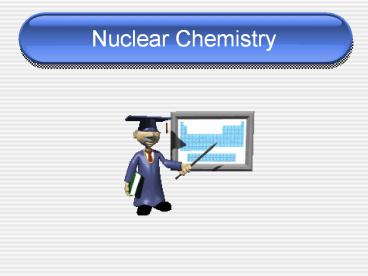Nuclear Chemistry - PowerPoint PPT Presentation
Title:
Nuclear Chemistry
Description:
Title: Nuclear Chemistry Author: a Last modified by: Michelle Nicole Buroker Created Date: 9/28/2005 12:41:06 AM Document presentation format: On-screen Show (4:3) – PowerPoint PPT presentation
Number of Views:187
Avg rating:3.0/5.0
Title: Nuclear Chemistry
1
Nuclear Chemistry
2
Nuclear vs. Chemical
- Occurs when bonds are ____________ and
____________ - Atoms remain ____________ , but they may be
rearranged - Involve only ____________
- Have ____________ energy changes
- Reaction rates are influenced by ____________ ,
____________ , ____________ , and ____________
- Occurs when nuclei emit ____________ and/or
____________ - Atoms of one element are ____________ into
another element - May involve ____________ , ____________ , or
_________ - Have ____________ energy changes
- Reaction rates are ____________
broken
particles
formed
rays
unchanged
converted
protons
neutrons
electrons
electrons
small
large
constant
heat
pressure
catalyst
concentration
3
Types of Radiation
- Unstable nuclei emit radiation to attain more
stable atomic configurations in a process called
____________ .
Radioactive Decay
Only about 7 of all atomic isotopes are stable
4
Types of Radiation
- The three most common types of radiation are
___________(a), __________ (ß), and
___________(?).
Alpha
beta
gamma
5
Alpha
- An ____________ (a) has the same composition as a
____________ nucleustwo protons and two
neutronsand is therefore given the symbol
____________ . - The charge of an alpha particle is ____________
due to the presence of the two protons.
Alpha particle
helium
Positive two
6
Alpha
- Because of their mass and charge, alpha particles
are relatively slow-moving compared with other
types of radiation. - Thus, alpha particles are not very penetrating
- ____________ stops alpha particles.
paper
7
Beta
- A ____________ (?) is a very-fast moving
____________ that has been emitted from a neutron
of an unstable nucleus. - Beta particles are represented by the symbol
____________ - The 1 subscript denotes the negative charge of
the particle. - Beta radiation consists of a stream of
____________
Beta particle
electron
Fast moving electrons
8
Beta
- Because beta particles are both lightweight and
fast moving, they have greater penetrating power
than alpha particles. - A ____________ is required to stop beta
particles.
Metal foil
9
Gamma
- ____________(?) are high-energy (short
wavelength) electromagnetic radiation. They are
denoted by the symbol ____________ - The emission of gamma rays does not change the
atomic number or mass number of a nucleus. - Gamma rays almost always accompany ____________
radiation.
Gamma rays
Alpha or beta
10
Gamma
- Gamma rays are high energy radiation
- They can only be blocked by ____________
Lead.
11
Deflection
- The effect of an electric field on three types of
radiation is shown. - Positively charged alpha particles are deflected
toward the ____________ charged plate.
negative
12
Deflection
- Negatively charged beta particles are deflected
toward the ____________ charged plate.
positive
13
Deflection
- Beta particles undergo greater deflection because
they have considerably ____________ than alpha
particles.
Less size (smaller)
14
Deflection
- Gamma rays, which have no electrical charge, are
____________ .
Not detected
15
Writing Nuclear Reactions
- When writing nuclear reactions, you must remember
the ___________________ - What you start with has to equal what you end
with - You also have to remember how to write formulas
for isotopes
Law of Conservation of matter
16
Nuclear Reactions
- Write the reaction for radium 226 converting into
radon 222
17
Nuclear Reactions
- Write the reaction of carbon-14 decaying into
nitrogen 14
18
Nuclear Reactions
- Write the reaction of uranim-238 undergoing alpha
and gamma decay
19
Half Life
- ____________ - time required for ½ of a
radioisotope to decay - For example
- You have 100 g of an isotope. How much is left
after 1 half life? - How much will be left after 2 half lives?
Half Life
20
Fission and Fusion
- ____________ splitting the nucleus into
fragments - Releases large amounts of ____________
- Nuclear power plants use fission to generate power
Nuclear Fission
Energy
21
Fission and Fusion
- ____________ combining of atomic nuclei
- Release large amounts of energy
- Require extremely ____________
- The lowest temperature possible is 40,000,000 K
- Know to occur on the sun
Nuclear Fusion
High temperatures































